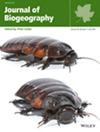Spatio-temporal shift in body size and plumage coloration is associated with the magnitude of climate change in a cosmopolitan owl
Abstract
Aim
Climatic gradients shape geographic variation in phenotypic traits that are involved in animal thermoregulation. Therefore, increasing temperatures under global warming are expected to cause change over time in traits that show predictable spatial patterns according to environmental clines (body and appendage size, tegument coloration), as well exemplified by biogeographic rules and shown by increasing literature at a local scale. However, whether temporal shifts in phenotypic traits vary spatially according to the magnitude of the change in local climatic conditions is still unknown.
Location
World.
Taxon
Barn owl species complex (Tyto alba group).
Methods
By using thousands of museum specimens collected across the globe from 1901 to 2018, we calculated within-population change over time in wing length, bill length and melanin-based plumage coloration and examined whether these trends differed across geographic regions, latitudes and gradients of climate changes.
Results
We showed that populations exposed to an increasing warmer climate were subjected to a more marked decrease in body size, as gauged by wing length, and also absolute bill length that displayed a similar, although less steep, pattern of shrinking over time. In addition, phaeomelanin-based ventral plumage colour has become paler in regions where the climate changed into warmer and drier, and darker where both temperature and precipitation increased.
Main Conclusions
These trends are generally coherent with the predictions based on Bergmann's and Gloger's rules, but not Allen's rule, and suggest that temporal shifts in body size and tegument colour depend on the magnitude of the alteration in climatic conditions, with populations living in regions where the climate has changed the most that are subjected to more marked phenotypic changes. Spatio-temporal variation in climate has driven within-species phenotypic clines, and it is expected to increase differences among populations according to the predicted further climate change.

 求助内容:
求助内容: 应助结果提醒方式:
应助结果提醒方式:


